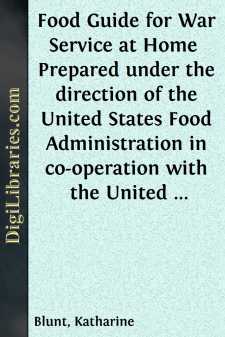Categories
- Antiques & Collectibles 13
- Architecture 36
- Art 48
- Bibles 22
- Biography & Autobiography 813
- Body, Mind & Spirit 142
- Business & Economics 28
- Children's Books 14
- Children's Fiction 11
- Computers 4
- Cooking 94
- Crafts & Hobbies 4
- Drama 346
- Education 46
- Family & Relationships 57
- Fiction 11828
- Games 19
- Gardening 17
- Health & Fitness 34
- History 1377
- House & Home 1
- Humor 147
- Juvenile Fiction 1873
- Juvenile Nonfiction 202
- Language Arts & Disciplines 88
- Law 16
- Literary Collections 686
- Literary Criticism 179
- Mathematics 13
- Medical 41
- Music 40
- Nature 179
- Non-Classifiable 1768
- Performing Arts 7
- Periodicals 1453
- Philosophy 64
- Photography 2
- Poetry 896
- Political Science 203
- Psychology 42
- Reference 154
- Religion 513
- Science 126
- Self-Help 84
- Social Science 81
- Sports & Recreation 34
- Study Aids 3
- Technology & Engineering 59
- Transportation 23
- Travel 463
- True Crime 29
Food Guide for War Service at Home Prepared under the direction of the United States Food Administration in co-operation with the United States Department of Agriculture and the Bureau of Education, with a preface by Herbert Hoover
by: Katharine Blunt
Categories:
Description:
Excerpt
CHAPTER I
Wheat is as much a war necessity as ammunition—wheat is a war weapon. To produce it and distribute it where it is needed and in sufficient quantities is the most serious food problem of the Allied world. The continent of Europe, with her devastated fields, can raise but a small fraction of the wheat she needs, and ships are so few that she cannot import it from many of the usual sources.
Not one of the warring European countries has escaped serious suffering, and the neutral countries have suffered with them.
THE WORLD'S SUPPLY OF WHEAT
France, always an agricultural nation, was the most nearly self-sustaining of the western Allies. Now one-third of her wheat-fields are barren. Thousands of her acres have been taken by the enemy, or are in No Man's Land. Much of the land that has been fought over these past four years is now hopeless for farming, and will be for years to come. Even the territory still under cultivation cannot be expected to yield large returns, for laborers, tools, and fertilizers are lacking.
The men who have left the fields to fight have been replaced chiefly by women, children, and old men, while furloughed soldiers at times help to bring in the crops. To get adequate return from the soil which has been tilled for centuries, tons of fertilizer are necessary. Fertilizers are an absolute necessity, and nitrates, one of the most important of them, can no longer be imported from Chile. The work-animals have been driven off by the enemy or slaughtered for want of food, and mechanics are lacking to repair and replace the worn-out farm-machinery. As a result of this, in 1917 France raised only enough wheat to supply 40 per cent of her need, instead of 90 per cent, as in pre-war years.
In England the situation is not much better. Unlike France, England has always imported far more wheat than she raised. But now through vigorous effort she alone of all the European countries has increased her cereal production so that it has actually been doubled. Being free from the devastation of war at home, she has been able to convert the great lawns of her parks and country estates into grain-fields. English women of all classes, an army of half a million, are working on the land. At the same time the consumption of wheat has been reduced. Even yet, however, the home-grown supply in England is only one-fourth of the wheat required.
In Belgium the devastation is so complete that the women, children, and old people left there would die of famine if food were not sent to them. Two and a half million Belgians daily stand in line waiting for food to be doled out to them. The United States must supply three-fourths of the wheat contained in their meagre bread ration. In Italy, too, the condition is serious, for she produces far less than she needs, despite every effort of her Government to stimulate production.
WHEAT FIELDS OF THE WORLDGermany and Austria-Hungary have not escaped universal suffering from lack of wheat. Germany before the war was a wheat-importing country, and Austria-Hungary was able to supply herself with wheat, but had none to export....


